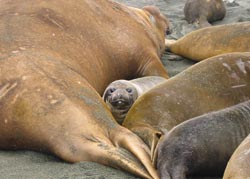
Dave
Morgans first trip south was to Macquarie Island, one of four
Australian Antarctic Research Bases.
While Dave was on Macquarie Island there were only 28 people. Made up
of 16 males and 12 females and all professional Scientists, Doctors or
Technicians.
Night-life on the remote island was what you made yourself. With no TV, no radio and no papers and only 1-2 hours of darkness in mid summer your lifestyle changes slightly. After the work was done we watched videos and organized special social nights. Saturday nights were company nights. Everyone dressed up and partied with free wine, beer and spirits and a big dinner.
On arrival and for approx 4 weeks we ate fresh vegetables.
But once they were gone it was frozen meat and tinned food. Although at
one stage one of the scientists had a vegetable garden going.
Duties on the island varied and some had some interesting extra tasks.
One was to look after the Home Brew. Keep the beer up to scratch and ready
for Saturday nights.
Dave said that his extra tasks were working with the
fur seal tagging team. Zoologist Becky caught the seals and Dave held
them down while Becky took a blood sample, biopsy, shaved a bit of fur
and painted on a serial number. Then the seal was weighed and set free
again.
Other members were specially trained to assist the on site Doctor. Dr
Cath was part of the team and available 24 hours a day and ready for any
emergency. From crushed shoulders, broken bones, pulled muscles and the
normal run of medical problems. Dr Cath from Melbourne, had a very well
equipped surgery including X-ray equipment.
Remembering just how far south Macquarie Island is, it
takes 4-5 days for a ship to get there and 4-5 days to return to Australia.
The team of 28 lived happily with no crime, no infighting and all working
in together. To be part of the ANARE (Australian National Antarctic Research
Expedition you first need to pass a fitness test and an Army Psychology
test. Dave was on the 54th ANARE Expedition.
Over the years 9 members have died while on an expedition. Some from accidents
and some from natural causes. It is not all plain sailing. Dave said that
they were caught in a dangerous situation with Zodiac boats and 4-5 meter
seas while delivering food supplies to remote sections of the island.
Dave told me a bit about the BOM work he performed at Macquarie.
The weather balloon is made of special quality latex rubber and comes in varying sizes. It depends on the payload, to which size balloon you use. The balloon carried a 350gram tracker to 80,000 feet before bursting. Information is collected by satellite and sent back to the BOM workshop on the island. Balloons are filled with home made hydrogen and information gathered includes the temperature, humidity, pressure, wind direction and speed. For interest sake today in Rockhampton the temperature at ground level was 24C and at 51,000feet it was –77.3C
One of Dave’s tasks was to take samples of air. The air was filtered for a week then pumped into sampling flasks at 96psi. The flasks and the filter pads were then shipped off to the CSIRO.
I was involved in other scientific programs too, like the fur seal program, expeditions to other islands and boating duties.
Macquarie Island is a geologist’s playground with unusual rocks and rock formations. It is an exposed crest from an undersea ridge caused by the Pacific Plate that meets the Indo Australian Plate. It is not uncommon to experience earthquakes during your stay on Macquarie. One while I was there measured 5.4 on the Richter Scale"
Dave said that the highlight was working along side Mother Nature at its wildest best. To experience 60-70 knot (108-126kph) winds in blizzard conditions, you have to experience it to believe it.
Macquarie Island, or "Macca" as it is generally referred to is 34 kilometres long and 5 kilometres wide at its widest point. It has a total surface area of 128 square kilometres. It is a Tasmanian State Reserve managed by the Tasmanian Parks and Wildlife Service
Wildlife on Macqurie Elephant and Fur seals breed on the island as do Royal, King, Gentoo and Rockhopper penguins. The Royal Penguin is only found on Macquarie Island. A penguin rookery at Hurd Point at the southern end of the island is home to over a million birds during the breeding season Other fauna on the island includes Skuas, Petrels and a number of different types of Albatross. There are no trees on the island although the island is covered by tussock grass and many other plants.








 |
 |



